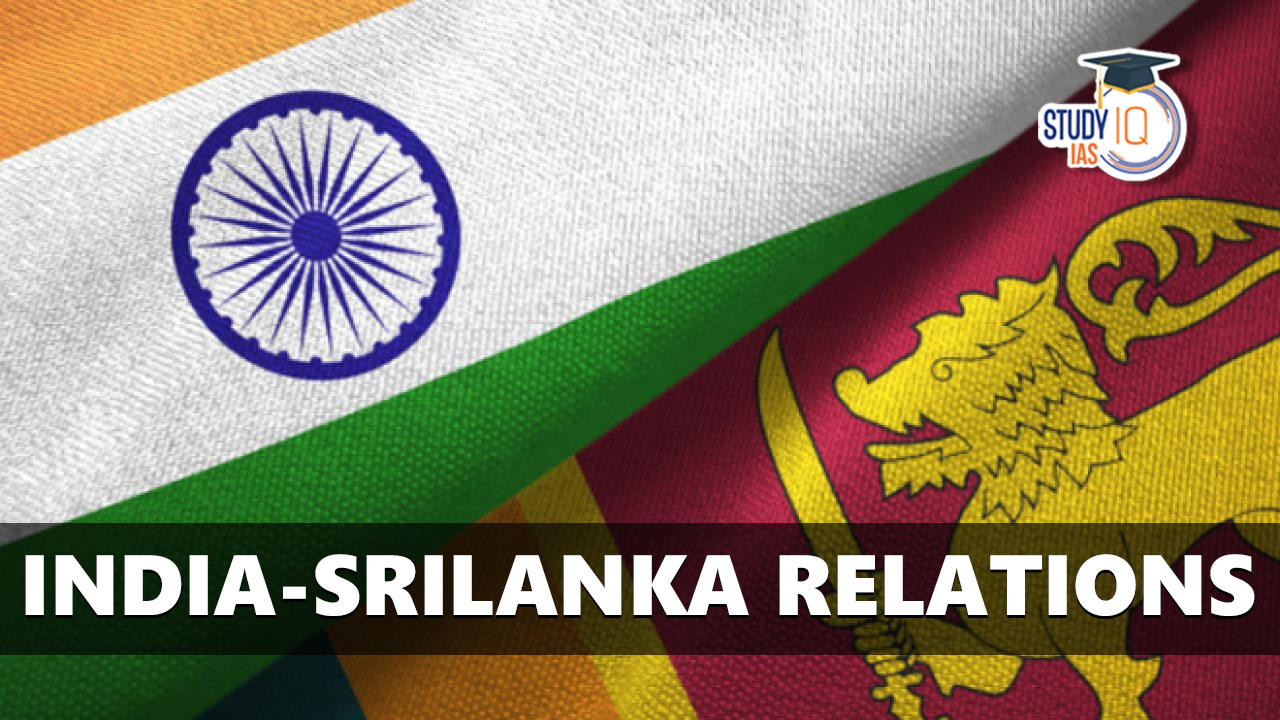Table of Contents
Context: India is said to positively transform its ties with Sri Lanka in the upcoming visit of President Wickremesinghe to India.
More on the News
- India has been extending its continuous support to Sri Lanka‘s during the recent economic crisis and both countries are engaged in negotiations regarding a debt treatment plan.
- Sri Lanka recognizes the importance of Indian tourists and investment for its economic recovery.
- Therefore, the purpose of the visit is to strengthen the bilateral relationship between the two countries.
India-Srilanka Ties
Evolution:
Pre-Independence Relations:
- The earliest mention of Sri Lanka in Indian history dates back to the epic of Ramayana, which mentions the rescue of Sita from Lanka by Lord Ram.
- Buddhism spread to Sri Lanka from India around 2000 years ago, establishing a cultural and religious connection between the two countries.
- The northern and northeastern regions of Sri Lanka have been historically had economically integrated with India.
- During the colonial period, Sri Lanka (then known as Ceylon) was under British rule but was administered separately and not as a part of British India.
- In the 19th century, British colonial authorities brought indentured labourers from India, mainly from Tamil Nadu, to work in Ceylon and eventually many Tamils settled in the northern part of the country.

Post-Independence Relations:
- India gained independence in 1947, followed by Ceylon in 1948.
- The Sinhalese-dominated government in Ceylon implemented discriminatory policies against Tamils, leading to strained relations between India and Ceylon.
- In 1964, the Shastri-Sirimavo Pact was signed, granting citizenship to a large number of Indian Tamils in Ceylon and facilitating repatriation to India.
- In the 1970s and 1980s, India’s allegiance shifted towards the Soviet Union, while Sri Lanka moved closer to the United States.
- Tensions between the Sinhalese and Tamil communities in Sri Lanka escalated, leading to violent incidents in 1977 and 1981.
- It is alleged that during this period, India’s Research & Analysis Wing (R&AW) provided training and support to Tamil rebel groups in Sri Lanka, aiming to destabilize the Sri Lankan government while preventing the creation of a separate Tamil state.
- The Liberation Tigers of Tamil Eelam (LTTE), a separatist militant group, emerged in 1976 and became a prominent force.
- The India-Sri Lanka Accord was signed in 1987, granting limited autonomy to Tamil areas.
- However, it faced opposition from Sinhalese nationalists who viewed it as interference in Sri Lanka’s internal affairs.
- The Indian Peacekeeping Force (IPKF) was deployed in Sri Lanka as part of the accord but faced resistance from both the LTTE and some sections of the Sri Lankan government.
- In 1990, the IPKF mission was ended, and India’s involvement in Sri Lanka reduced.
Post-Cold War Period Relations:
- With the end of the Cold War, India adopted a more outward-looking approach and sought to improve relations with neighboring countries, including Sri Lanka.
- The India-Sri Lanka Free Trade Agreement was signed in 1998, aiming to enhance economic cooperation.
- India encouraged dialogue and a ceasefire between Sri Lanka and the LTTE from 2000 to 2003, although it did not have direct involvement.
- The period from 2005 to 2009 saw the intensification of the civil war in Sri Lanka, with the Sri Lankan government launching a military offensive against the LTTE.
- The LTTE’s leader, Velupillai Prabhakaran, was killed in 2009, and the LTTE was militarily defeated.
- During this period, Sri Lanka developed closer ties with Pakistan and China, leading to concerns in India about security implications and increased influence of these countries in Sri Lanka.
- China’s involvement in infrastructure development, including the Hambantota port, raised strategic concerns for India.
Current Focus of India-Sri Lanka Ties:
- Both countries continue to engage in economic cooperation and bilateral discussions on various issues, including trade, investment, tourism, and regional security.
- India and Sri Lanka have ongoing collaboration in areas such as infrastructure development, maritime security, counterterrorism, and cultural exchanges.
Areas of Cooperation
Political:
- Political relations between the two countries have been marked by high-level exchanges of visits at regular intervals.
- In 2019, the first overseas visit of Indian Prime Minister to Sri Lanka, was an important symbolic gesture reflective of the special relationship between the countries and the government’s focus on its Neighbourhood First Policy.
- Sri Lanka is a member of regional groupings like BIMSTEC (Bay of Bengal Initiative for Multi-Sectoral Technical and Economic Cooperation) and SAARC in which India plays a leading role.
- Sri Lanka has long been in India’s geopolitical orbit, but its relationship with China has strengthened in recent years.
- Former President Rajapaksa took Sri Lanka closer to China and side-lining Indian concerns including the rehabilitation of Tamils displaced by the long-running Sri Lankan civil war.
Economic Relations:
- Sri Lanka is one of India’s largest trading partners in SAARC, while India is Sri Lanka’s largest trade partner globally.
- Trade between the two countries grew rapidly particularly after the entry into force of the India-Sri Lanka Free Trade Agreement in 2000.
- India is among the top four investors in Sri Lanka with investments in diverse areas including petroleum retail, IT, financial services, real estate, telecommunication, hospitality & tourism, banking and food processing (tea & fruit juices), metal industries, tires, cement, glass manufacturing, and infrastructure development (railway, power, water supply).
- India is also one of the largest contributors to Foreign Direct Investment in Sri Lanka. According to BoI, FDI from India amounted to about US$ 1.7 billion during the period 2005 to 2019.
- In 2020, India was Sri Lanka’s 2nd largest trading partner with the bilateral merchandise trade amounting to about USD $ 3.6 billion.
- Sri Lankan exports to India have increased substantially since 2000 when ISLFTA came into force and more than 60% of Sri Lanka’s total exports to India over the past few years have used the ISFTA benefits.
Development:
- The Government of India has committed significant financial assistance to Sri Lanka, with grants alone amounting to approximately USD 570 million, and the overall commitment exceeding USD 3.5 billion.
- This financial support is utilized for a wide range of development projects in Sri Lanka, including the following sectors:
- Housing: This initiative aims to provide housing units to internally displaced persons affected by the LTTE war and the humanitarian crisis.
- Infrastructure: India has been involved in rehabilitation of the Northern Railway lines and wreck removal, which contribute to improving transportation connectivity in the region.
- Vocational Training and Education: India has supported the establishment of vocational training centers in Sri Lanka, which aim to enhance skills and employability.
- Culture and Heritage: India has been involved in the construction of a Cultural Centre at Jaffna and the restoration of the Thiruketheeswaram Temple.
Defence Cooperation:
- The two countries have increased their military-to-military relationship, conducting joint exercises such as the ‘Mitra Shakti’ military exercise and SLINEX naval exercise.
- India also provides defence training to the Sri Lankan forces, enhancing their capabilities and cooperation in the security domain.
- In addition, a trilateral maritime security cooperation agreement was signed between India, Sri Lanka, and the Maldives, focusing on improving surveillance, anti-piracy operations, and reducing maritime pollution in the Indian Ocean Region.
- Both countries have also collaborated on countering drug and human trafficking, signing an agreement in April 2019 to address these challenges effectively.
Issues in India Srilanka Relations
There are several key issues in India-Sri Lanka relations that have been a source of concern and have impacted the bilateral relationship.
- Killing of Fishermen: The killing of Indian fishermen by the Sri Lankan Navy has been a longstanding issue between the two countries. Incidents of Indian fishermen being arrested and their boats being confiscated by Sri Lankan authorities have strained relations. In 2019 and 2020, a significant number of Indian fishermen were arrested, and several Indian boats were seized.
- Influence of China: China’s growing economic presence and political influence in Sri Lanka have raised concerns for India. China has become the largest investor in Sri Lanka, accounting for a significant share of foreign direct investment (FDI) in the country. This has led to apprehensions regarding the impact of China’s influence on the strategic balance in the region and strained India-Sri Lanka relations.
- 13th Amendment of the Sri Lankan Constitution: The 13th Amendment of the Sri Lankan Constitution was introduced to address the demands of the Tamil community for equality, justice, peace, and respect within a united Sri Lanka. India supports the full implementation of the 13th Amendment, which envisages devolving powers to provincial councils. However, the Sri Lankan government is yet to fully implement the amendment, leading to tensions and differences of opinion on this matter.


 Editorial of the Day (17th May): Right t...
Editorial of the Day (17th May): Right t...
 Supreme Court Judgement on Private Prope...
Supreme Court Judgement on Private Prope...
 Current Affairs 17th May 2024 for UPSC P...
Current Affairs 17th May 2024 for UPSC P...

















